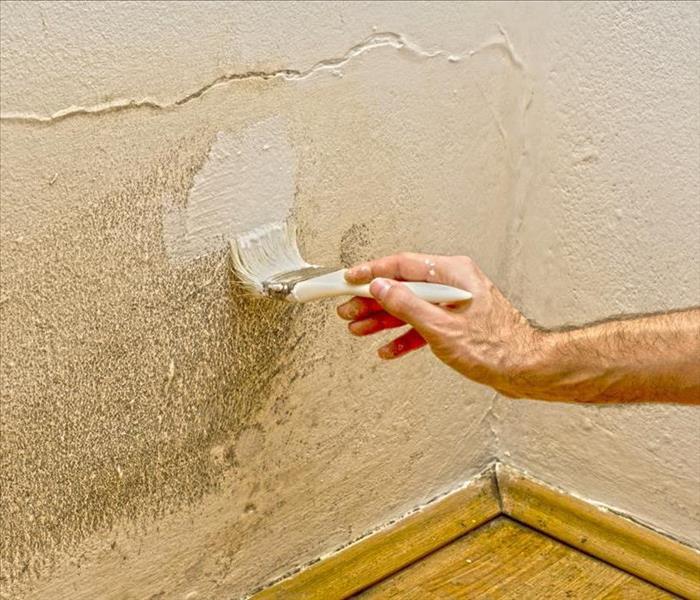5 Mold Remediation Don’ts to Avoid
5/7/2018 (Permalink)
 Painting over mold is looked at as the cheapest option for many property manager and homeowners but only limits your ability to visibly notice growth.
Painting over mold is looked at as the cheapest option for many property manager and homeowners but only limits your ability to visibly notice growth.
There are plenty of myths out there in regards to proper mold remediation and what actually works. New discoveries about mold are made all the time, and the recommended processes for treatment improves and adapts along with each discovery made. Because of this, predated information still exists and homeowners and property managers tend to use techniques that either make a mold situation worse or have no effect at all. Here are our top five mold remediation don’ts to avoid.
1. Bleach
The most common don’t when it comes to mold remediation is the use of bleach for the cleaning or removal of mold. While at one point The Occupational Safety and Health Administration (OSHA) recommended the use of chlorine bleach in mold abated, they were the first to retract their recommendation. The Environmental Protection Agency has since retracted their recommendation as well.
The truth when it comes to using chlorine bleach is that it actually CAN kill certain mold types (Aspergillus niger and Trichophyton mentagrophytes) when used on a non-porous surface. The main problems with this are that there are many other types of mold and remediation typically involves disinfecting wood and wood-based building materials, all of which are porous materials. Because the properties of chlorine bleach prevent it from soaking into wood-based materials, the bleach is not able to reach and affect the roots of the mold to stop it at its source. Mold membranes will recognize bleach as a threat, retreat further into the material to avoid it, and in some case, mold can even use the bleach as a fungal food to grow more rapidly. Yes, bleach can potentially make the problem worse! Be wary of any restoration company that recommends the use of bleach as a solution to your mold problems.
2. Vinegar
Another popular household item that is often used to deal with mold is vinegar. Vinegar is mildly acidic and actually can kill about 82% of mold species. However, when treating mold as a homeowner, you must be aware that visible mold growth in your property may not be the only area that is affected. Choosing this option runs the risk of missing additional mold growth within your property, leaving you unknowingly open to an increasingly worse mold situation. Seeking professional mold testing is always the best option for determining how bad your mold situation is, as well as determining the type of mold you are dealing with. In most cases, calling a professional mold remediation company is the best option, especially when the mold is widespread.
3. Scraping Off
One misconception is that you can remove mold by simply scraping it off. This is a big don’t for a few reasons. Mold is a living organism and disturbing it releases spores into the air which can potentially be breathed in. These released spores also cause the mold to contaminate other accessible areas of the property helping the mold to spread throughout. Scraping mold not only means a significantly higher bill for treating and removing it but also poses an increased health risk for all inhabitants of the property.
4. Ignoring Mold
Aside from making the decision to remediate on their own, many homeowners and property managers also make the decision to leave the mold as is. There are an enormous amount of risks involved when ignoring signs of mold. Mold that is exposed and left untreated is at high risk of being disturbed and spreading. Prolonged exposure to mold, visible or otherwise, can have different effects on people’s health. Another issue with leaving mold untreated is the structural damage that it can cause to your property. The longer that mold is ignored, the bigger your problems will be down the line across the board.
5. Painting Over
Due to either a lack of knowledge on mold or in some cases pure negligence, there are plenty of property managers, landlords and/or homeowners that choose to hide mold by painting over it. One of the biggest issues in property managers doing this is that it limits the inhabitants from quickly noticing the mold. Mold can eat through the majority of paints and become exposed again. By the time this happens, the mold growth is usually significantly worse. There are also mold resistant paints that are misconstrued as a viable option for painting over mold. These paints are intended to be used prior to mold growth on a clean surface to prevent the growth from happening. Using these paints will not take care of the issue and will only prevent you from noticing the problem get worse.
Local Mold Remediation Services
If you notice mold growth in your home or property, call the professionals here at SERVPRO of Winter Park. Our phone line 407-837-8990 is open 24/7 to assist you with your mold disaster.





 24/7 Emergency Service
24/7 Emergency Service